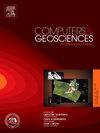A self-attention convolutional long and short-term memory network for correcting sea surface wind field forecasts to facilitate sea ice drift prediction
IF 4.4
2区 地球科学
Q1 COMPUTER SCIENCE, INTERDISCIPLINARY APPLICATIONS
引用次数: 0
Abstract
Accurate and timely correction of numerically forecasted sea surface wind fields is essential for sea ice drift prediction. However, current oceanic element prediction systems face two major challenges. The numerically forecasted sea surface wind fields are timely, but their accuracy is often limited. In contrast, reanalysis sea surface wind fields are more accurate but lack timeliness, limiting their applicability in urgent requirements. To address these challenges, a self-attention convolutional long and short-term memory network (SaCLN) has been developed for intelligently correcting the numerically forecasted sea surface wind fields. This approach combines the timeliness of the numerically forecasted wind fields with the accuracy of reanalysis wind fields to generate corrected wind fields that closely approximate the reanalysis wind fields. This network consists of a self-attention network and a convolutional long and short-term memory network (CLN). The self-attention network captures the global spatial correlations of a numerically forecasted sea surface wind field sequence. The CLN extracts the spatial and temporal characteristics of an attention weighted wind field sequence. The trained SaCLN model can effectively generate accurate and timely corrected wind fields, thereby enhancing the accuracy of sea ice drift prediction. The effectiveness of the SaCLN was validated through experiments predicting the drift of Arctic sea ice and Antarctic icebergs. Experimental results show that the drift results based on wind fields corrected by the SaCLN are more accurate than those based on numerically forecasted sea surface wind fields. This method has demonstrated its effectiveness in sea ice drift prediction, assisting researchers in better addressing the challenges posed by sea ice variability.
海面风场预报校正的自注意卷积长短期记忆网络促进海冰漂移预报
准确、及时的海面风场数值预报对海冰漂移预报至关重要。然而,目前的海洋元素预测系统面临着两大挑战。海面风场的数值预报是及时的,但精度往往有限。海面风场再分析虽然精度较高,但时效性较差,限制了其在紧急情况下的适用性。为了应对这些挑战,研究人员开发了一种自关注卷积长短期记忆网络(SaCLN),用于智能校正数值预报的海面风场。该方法将数值预报风场的时效性与再分析风场的准确性相结合,生成与再分析风场非常接近的校正风场。该网络由自注意网络和卷积长短期记忆网络组成。自关注网络捕获数值预报的海面风场序列的全球空间相关性。CLN提取了一个关注加权风场序列的时空特征。经过训练的SaCLN模型可以有效地生成准确、及时的风场校正,从而提高海冰漂移预测的精度。通过预测北极海冰和南极冰山漂移的实验,验证了SaCLN的有效性。实验结果表明,基于SaCLN校正的风场漂移结果比基于数值预报的海面风场漂移结果更准确。该方法已在海冰漂移预测中证明了其有效性,有助于研究人员更好地应对海冰变率带来的挑战。
本文章由计算机程序翻译,如有差异,请以英文原文为准。
求助全文
约1分钟内获得全文
求助全文
来源期刊

Computers & Geosciences
地学-地球科学综合
CiteScore
9.30
自引率
6.80%
发文量
164
审稿时长
3.4 months
期刊介绍:
Computers & Geosciences publishes high impact, original research at the interface between Computer Sciences and Geosciences. Publications should apply modern computer science paradigms, whether computational or informatics-based, to address problems in the geosciences.
 求助内容:
求助内容: 应助结果提醒方式:
应助结果提醒方式:


